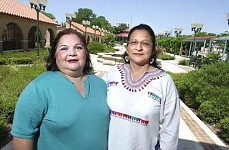In Austin, Safety Comes at a (Too) High Price
The city's inflated budgets may have left Austin ped / bike projects empty-handed.
By Lauri Apple, Fri., March 21, 2003

Recently the Texas Dept. of Transportation announced the 27 projects that have won funding for Safe Routes to Schools -- a state/federal program created to improve pedestrian and bicycle safety -- and while the list includes projects in Pflugerville and San Marcos, none of Austin's nine projects, involving 11 schools, made the cut. That may be because those projects' budgets, say TxDOT representatives and bicycle advocates, were astronomical compared to those in other cities.
TxDOT spokesman Mark Cross says that among the 190-plus projects submitted by Texas cities and counties, Austin was "the only city" whose projects were so expensive -- particularly for "planning, specifications, and estimates," the preconstruction phase. PS&E costs normally range between 10% and 20% of the construction budget, Cross says, but on seven of Austin's nine projects, they exceeded the 100% mark -- that is, the planning cost more than the actual construction. PS&Es for the other two projects were 94% and 96% of the construction cost. Cross said this "probably has some bearing as to why [Austin's] projects weren't selected." The winning projects adhered to more customary PS&E figures. For example, Pflugerville estimated that its $151,000 sidewalk project required just $25,000 for PS&E, or 20%, and San Marcos got $15,000 for a $18,000 sidewalk project that required no PS&E money at all.
Do Austin's unique features make it that much more expensive to design and build even small-scale safety projects? Perhaps, says Tom Benz, project manager with the city's Public Works Dept. In general, "the cost of doing business here and overhead rates are higher than in other cities." The city staff that prepared the Safe Routes application may also have prepared more detailed estimates than did other cities' engineers, Benz speculates. "I can't speak for what other applicants put together in their estimates. They might have underestimated." As for construction and engineering issues posed by the local landscape, Benz contrasts Austin's Hill Country characteristics to places like Houston, "where it's relatively flat."
But it seems inconceivable that Austin's budgets should be so far above those of a large pool of applicants all across the state. It's unlikely that all of them lowballed their planning costs, and not all cities and counties (or school sites within them) are as flat as Houston. Benz's department came up with the estimates for Safe Routes projects, but the city's Transportation, Planning, and Sustainability Dept. reviewed price estimates and conducted the final application preparation. (TPSD Director Austan Librach, who signed off on the city's applications, couldn't be reached for comment.) Overall, Benz feels the city assembled accurate PS&E and construction estimates. "Some [projects] were very challenging," he said. "You're not just putting down sidewalk on a flat terrain."
But not all Austin projects involved laying sidewalks. A project at Sanchez Elementary, for example, consisted of signage and three rumble strips. That project's budget was $160,000, with a PS&E estimate of 123% the construction cost. "We were asking for a few signs -- nothing very expensive," said Lori C-Renteria of the East Cesar Chavez Neighborhood Planning Team. Or so she thought.
This year, TxDOT had a little over $5 million to award for Safe Routes, which direct state and federal funds toward safety projects located within two miles of schools. For this year's projects, the Austin City Council approved $1 million in matching funds, which will now be applied to other projects. Benz says Public Works is open to ideas to lower costs on Safe Routes projects. "If TxDOT has a way to make these projects cheaper, basically, then I'm positive the city of Austin's all ears to that."
Meanwhile, TxDOT spokesman Cross says the department is "not sure" if the feds will set aside money for Safe Routes next year. The federal Transportation Equity Act for the 21st Century (TEA-21) expires this year, and given the sagging economy, no one can predict what might happen to pedestrian safety funding. On the state level, the Matthew Brown Act, passed in 2001, mandates that money be set aside for Safe Routes; if no federal funding is made available, the state will have to look for a new funding stream. State Rep. Beverly Woolley, R-Houston, has filed HB 3020, which creates "God Bless Texas" and "God Bless America" license plates; money generated from plates sold will go toward Safe Routes.
The "God Bless" license plates -- the idea of Texas Transportation Commission Chairman John W. Johnson -- show TxDOT's "extraordinary commitment" to make Safe Routes work, says Robin Stallings of the Texas Bicycle Coalition, who chaired TxDOT's Bicycle Advisory Committee during the Safe Routes project selection process. Though TxDOT often inspires grumbling among opponents of pavement worship, Stallings says TxDOT staff "worked their buns off" to make Safe Routes happen. So did Austin neighborhood groups submitting projects, he says, adding that his committee was "impressed" with the quality of many of the Austin projects. "I certainly hope the applicants are not discouraged and they reapply in the future, or that Austin finds a way to locally fund these very worthy projects that will save lives and improve the quality of life."
Got something to say on the subject? Send a letter to the editor.








